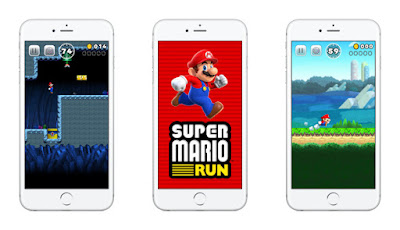I like android phones. However when mostfriends and family ask me what phone to buy, I tend to suggest the iPhone over android. Here’s why.
Let me begin by saying that i like android
phones. i like the variability of hardware and myriad software customization
choices. Samsung's Galaxy S9 and Google pixel 2 are especially compelling for
those who need the sexiest design and most compelling camera, respectively.
however when most friends and family ask me what phone to buy, I tend to
suggest the iPhone over android.
Notice that I didn't say "iOS over Android." The reason to go the Apple route with the iPhone 8, iPhone 8 Plus and iPhone X isn't just the platform; it's how the software and hardware complement each other. The iPhone also works seamlessly with other Apple gadgets, including Macs, the Apple Watch and Apple TV — there's an ecosystem factor. Here are 10 reasons why the iPhone beats Android.

Notice that I didn't say "iOS over Android." The reason to go the Apple route with the iPhone 8, iPhone 8 Plus and iPhone X isn't just the platform; it's how the software and hardware complement each other. The iPhone also works seamlessly with other Apple gadgets, including Macs, the Apple Watch and Apple TV — there's an ecosystem factor. Here are 10 reasons why the iPhone beats Android.
Updated on Apr 12: in line with
our testing, the pixel 2 is currently the best camera phone. the most recent
iPhones offer great cameras, however they are no longer tops.
1. Much, much faster.
If you’re thinking of shopping for
the iPhone 8, iPhone 8 plus or iPhone X, know that the A11 Bionic chip inside
blows away something from the android camp. Not only did this processor pace
Apple’s flagship massive|to very large} wins in synthetic benchmarks like
Geekbench 4 and 3DMark; it additionally ran circles around the likes of the
Galaxy Note 8 and also the pixel 2 XL when doing things like editing 4K video and
opening large files. Even the newer Galaxy S9 is more than double as slow.
This speed distinction should
conjointly make playing the foremost intensive games, and particularly enjoying
exigent augmented-reality apps, a smoother experience.
2. higher hardware and software
integration.
The 3D touch display 1st
introduced with the iPhone 6s and featured in all however one model released
since then is smart enough to sense pressure, permitting you to require fast
actions from the home screen simply by long-pressing on an app icon. The
Portrait Mode on the iPhone 8 plus will add sophisticated lighting effects with
a tap. and also the iPhone X will scan your face to log you in, although you
grow a beard and start wearing glasses. android phone manufacturers are said to
be 2 years behind Apple's Face ID.
These are just some of the samples
of how Apple’s hardware and software system designers work together to form the
iPhone better than android. And it’s no coincidence that Google recently spent
over $1 billion to accumulate HTC’s smartphone business. It wants to re-create
that very same magic by better integrating its mobile OS with its devices.
3. easiest phone to use.
Despite all the guarantees by
android phone manufacturers to streamline their skins, the iPhone remains the
simplest phone to use by far. Some could lament the shortage of modification in
the look and feel of iOS over the years, however I consider it a plus that it
works pretty much the same as it did way back in 2007. Pick it up, turn it on,
touch the app to open.
Of course, Apple has folded in
enhancements over the years, like Siri and control center. however the iPhone
still has zero learning curve. With iOS 10, Apple opened Siri and iMessages to
developers, and there are customizable widgets offered for the nowadays screen.
thus you cannot really create the argument that the iPhone is a walled garden
anymore. And with iOS 11, Apple has added the ability to edit Live Photos, send
payments to friends in the Messages app and organize files via a correct Files
app (which is much overdue considering that android has had files access from
the start).
4. OS updates when you want them.
This is going to hurt a little,
android fanboys. One week after launch, iOS 11 was reportedly installed on 25 %
of iOS devices, in accordance with analytics company Mixpanel. By Jan 2018, iOS
11 was on 65 % of iOS devices. Meanwhile, android oreo was on 0.7 % of devices
at that time.
The problem is this: With the
exception of pure android phones just like the pixel 2, the Samsungs, LGs and
HTCs of the world need to jump through more hoops to bring you the latest
version of Google's OS, including carrier certification. Plus, phone
manufacturers generally drag their feet on updating older phones. In fact, LG
recently established a package Upgrade Center to speed up updates.
If you own a compatible iPhone —
an iPhone 5s or later within the case of iOS 11 — you'll be able to update to
the latest version of iOS on the day it's released (or close to it, depending
on how Apple's servers stand up to the strain). This dynamic is not going to
change anytime soon.
5. the best apps first.
Now that both iOS and android have
countless apps in their stores, the race is over, right? Not really. The iPhone
continues to be favored by developers as the launch platform of alternative for
the hottest new apps.
-Mario Run debuted on iOS in Dec
2016. Android? March 2017.
-Mario Run debuted on iOS in Dec
2016. Android? March 2017.

The Google Play store is just like
the Netflix of app stores; it gets the hits, however sometimes after they see
their 1st run on iOS. as an example, it took 2 years for Instagram to debut on
android after it launched for the iPhone. Other apps, like Super Mario Run and
also the HQ trivia have taken only months to induce to android. other apps that
hit the iPhone before android include Monument valley 2, Affinity photo and
Snapchat.The message is clear: For those who don't desire to be treated like
second-class app citizens, the iPhone is still the king.
6. No bloatware!
It's not a good sign for
prospective android phone buyers that some of the most popular articles we do
are bloatware-removal guides.
Samsung and others have gotten
better at minimizing the pain for users by lumping all carrier bloatware into
one folder, however it's still simply crap taking up space on your phone.
You won't find a single piece of
carrier software preloaded on an iPhone, creating for a clean out-of-the-box
experience. Apple does include some apps you may not need or want, like Apple Watch,
however it's rather more restraint than other makers when it comes to bundling
its own stuff. And on iOS 11, you'll be able to at least disable built-in apps
you do not would like.
7. Works fantastically with Macs.
If you haven't tried a mac in a while,
you would possibly be stunned to know simply how well iPhones work with them.
for example, with the Continuity feature in macOS, you'll be able to use your
MacBook to send and receive text messages and even receive and place calls. All
you have to do is keep your iPhone close.
I find the handoff feature a bit
less useful, however some could like that they can do things like begin an
email on their mac and then pick up where they left off on their iPhone — or
vice versa. thanks to iCloud keeping everything in sync, you also have easy
accessibility on your mac to the photos you take on your iPhone, as well as any
notes or documents you create.
In iOS 11, a new Files app makes
it easier to keep your files in synchronize across iCloud and your mac. With
macOS high sierra, the Photos app has become more iOS-like, with a new memories
view, the ability to edit Live Photos and an improved people album, so it’s
fairly seamless to transition from iOS to macOS.
8. Apple Pay.
Between android Pay and Samsung
Pay, Apple has lots of rivals, however right now, Apple Pay is the most popular
method for making mobile payments. It’s also dead-simple to use. All you have
to do to use Apple Pay is bring your iPhone close to the supported payment
terminal at the checkout counter and then press your finger on your phone's
touch ID detector.
With the iPhone X, you simply
double tap the side button and then stare at your phone to use Face ID.
If you’re not that excited by
using your phone to pay for stuff at the shop, you'll be able to try another
alternative: iOS 11 supports sending and receiving money from friends and
family from within the Messages app. Yes, there are third-party apps that do
this, however with the iPhone, it’s designed right in.
Unfortunately, the funds you send
and receive are stored on a pay cash card and should then be transferred to
your bank. I’d like that funds go directly into the account related to your
Apple Pay account
9. Family Sharing.
An Apple family that plays
together saves together. With Family Sharing on the iPhone, Mom, Dad and the
kids can share purchases from the App Store, iTunes and iBooks with up to six
people. You can still keep your own iTunes accounts, too. When Junior wants to
make a purchase, you receive an alert via the Ask to Buy feature, so you can
keep better tabs on what he's downloading and also prevent bill shock.
You can choose between a 200GB
iCloud storage plan for the family ($2.99 per month for 200GB or $9.99 per
month for 2TB).
Other Family Sharing features
include shared photo albums, a shared calendar and the ability to see where
your kids are on a map at any time. Google doesn't offer easy family sharing on
Android devices, but Android does benefit from a much better selection of
parental-controls apps.
10. Best support and help.
When you have a problem with your
Android phone, you can try finding a solution on online forums or calling your
carrier. But with the iPhone, you can tap into a vast database of useful help
articles on Apple's website, get help via live chat or schedule an appointment
at an Apple Store Genius Bar.
With the exception of the Pixel,
Google doesn't have this kind of direct relationship with its customers. For
other Android phones, you have to go through your carrier or the phone maker,
and you won’t see the same level of service
See Also : iphone
X all Features & tips














Aucun commentaire:
Enregistrer un commentaire